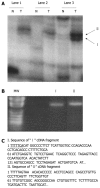β-catenin accumulation in nuclei of hepatocellular carcinoma cells up-regulates glutathione-s-transferase M3 mRNA
- PMID: 21483640
- PMCID: PMC3072644
- DOI: 10.3748/wjg.v17.i13.1772
β-catenin accumulation in nuclei of hepatocellular carcinoma cells up-regulates glutathione-s-transferase M3 mRNA
Abstract
Aim: To identify the differentially over-expressed genes associated with β-catenin accumulation in nuclei of hepatocellular carcinoma (HCC) cells.
Methods: Differentially expressed genes were identified in radiation-induced B6C3 F1 mouse HCC cells by mRNA differential display, Northern blot and RT-PCR, respectively. Total glutathione-s-transferase (GST) activity was measured by GST activity assay and β-catenin localization was detected with immunostaining in radiation-induced mouse HCC cells and in HepG2 cell lines.
Results: Two up-regulated genes, glutamine synthetase and glutathione-s-transferase M3 (GSTM3), were identified in radiation-induced mouse HCC cells. Influence of β-catenin accumulation in nuclei of HCC cells on up-regulation of GSTM3 mRNA was investigated. The nearby upstream domain of GSTM3 contained the β-catenin/Tcf-Lef consensus binding site sequences [5'-(A/T)(A/T) CAAAG-3'], and the total GST activity ratio was considerably higher in B6C3F1 mouse HCC cells with β-catenin accumulation in nuclei of HCC cells than in those without β-catenin accumulation (0.353 ± 0.117 vs. 0.071 ± 0.064, P < 0.001). The TWS119 (a distinct GSK-3β inhibitor)-induced total GST activity was significantly higher in HepG2 cells with β-catenin accumulation than in those without β-catenin accumulation in nuclei of HCC cells. Additionally, the GSTM3 mRNA level was significantly higher at 24 h than at 12 h in TWS119-treated HepG2 cells.
Conclusion: β-catenin accumulation increases GST activity in nuclei of HCC cells, and GSTM3 may be a novel target gene of the β-catenin/Tcf-Lef complex.
Keywords: Differential display analysis; Glutathione-s-transferase M3; Hepatocellular carcinoma; Radiation; β-catenin accumulation.
Figures




Similar articles
-
Wnt signaling in hepatocellular carcinoma: analysis of mutation and expression of beta-catenin, T-cell factor-4 and glycogen synthase kinase 3-beta genes.J Gastroenterol Hepatol. 2003 Mar;18(3):280-7. doi: 10.1046/j.1440-1746.2003.02973.x. J Gastroenterol Hepatol. 2003. PMID: 12603528
-
Wnt/beta-catenin signaling activates and determines hepatic zonal expression of glutathione S-transferases in mouse liver.Toxicol Sci. 2010 May;115(1):22-33. doi: 10.1093/toxsci/kfq033. Epub 2010 Jan 30. Toxicol Sci. 2010. PMID: 20118494
-
Silencing of lemur tyrosine kinase 2 restricts the proliferation and invasion of hepatocellular carcinoma through modulation of GSK-3β/Wnt/β-catenin signaling.Biochem Biophys Res Commun. 2019 Oct 1;517(4):722-728. doi: 10.1016/j.bbrc.2019.07.122. Epub 2019 Aug 5. Biochem Biophys Res Commun. 2019. PMID: 31395338
-
Liver cancer: WISP3 suppresses hepatocellular carcinoma progression by negative regulation of β-catenin/TCF/LEF signalling.Cell Prolif. 2019 May;52(3):e12583. doi: 10.1111/cpr.12583. Epub 2019 Feb 22. Cell Prolif. 2019. PMID: 30793395 Free PMC article.
-
A review of the relatively complex mechanism of JS-K induced apoptosis in cancer cells.Transl Cancer Res. 2019 Aug;8(4):1602-1608. doi: 10.21037/tcr.2019.07.20. Transl Cancer Res. 2019. PMID: 35116903 Free PMC article. Review.
Cited by
-
Effect of Long-term In Vitro Lithium Exposure on mRNA Levels of Claudin-3, CYP1A1, ABCG2 and GSTM3 Genes in the hCMEC/D3 Human Brain Endothelial Cell Line.Eur J Drug Metab Pharmacokinet. 2017 Dec;42(6):1013-1017. doi: 10.1007/s13318-017-0412-3. Eur J Drug Metab Pharmacokinet. 2017. PMID: 28367588
-
GSTM3 Function and Polymorphism in Cancer: Emerging but Promising.Cancer Manag Res. 2020 Oct 20;12:10377-10388. doi: 10.2147/CMAR.S272467. eCollection 2020. Cancer Manag Res. 2020. PMID: 33116892 Free PMC article. Review.
-
Extract of the Blood Circulation-Promoting Recipe-84 Can Protect Rat Retinas by Inhibiting the β-Catenin Signaling Pathway.Int J Mol Sci. 2018 Sep 11;19(9):2712. doi: 10.3390/ijms19092712. Int J Mol Sci. 2018. PMID: 30208636 Free PMC article.
-
Phylogenetic inference from single-cell RNA-seq data.Sci Rep. 2023 Aug 8;13(1):12854. doi: 10.1038/s41598-023-39995-6. Sci Rep. 2023. PMID: 37553438 Free PMC article.
-
1,25-Dihydroxyvitamin D Regulation of Glutamine Synthetase and Glutamine Metabolism in Human Mammary Epithelial Cells.Endocrinology. 2017 Dec 1;158(12):4174-4188. doi: 10.1210/en.2017-00238. Endocrinology. 2017. PMID: 29029014 Free PMC article.
References
-
- Llovet JM, Burroughs A, Bruix J. Hepatocellular carcinoma. Lancet. 2003;362:1907–1917. - PubMed
-
- Takada S, Koike K. Activated N-ras gene was found in human hepatoma tissue but only in a small fraction of the tumor cells. Oncogene. 1989;4:189–193. - PubMed
-
- Calvisi DF, Thorgeirsson SS. Molecular mechanisms of hepatocarcinogenesis in transgenic mouse models of liver cancer. Toxicol Pathol. 2005;33:181–184. - PubMed
Publication types
MeSH terms
Substances
LinkOut - more resources
Full Text Sources
Medical
Research Materials

